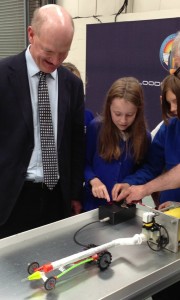Bristol’s innovative Bloodhound project to break the world land-speed record with a 1,000 mph jet-powered racing car today received a £1m boost from the Government.
The announcement came as science minister David Willetts officially opened the project’s new technical centre at Avonmouth where the pioneering car – the most powerful land vehicle ever created – is now being assembled.
Mr Willetts said the £1m grant recognised the project’s success in inspiring children about science, technology, engineering and mathematics (STEM) and would support its education and outreach mission. Some 5,340 UK schools, spanning primaries, secondaries and special educational needs colleges, have already used Bloodhound materials in class to inspire the next generation of engineers.
The new grant, to come through the Engineering and Physical Sciences Research Council (EPSRC), a founder sponsor of the Bloodhound programme, will help the Project’s education team and 500 ambassadors extend this work and inspire more children about STEM subjects.
The minister praised many of project partners, including Rolls-Royce which provided the Bristol-built Eurofighter engine and the Armed Forces before introducing two of the young people who have been inspired enough by the project to make engineering their career.
“The Government are great admirers of the project. We can be very proud in Britain of what we do,” said Mr Willetts.
“Bloodhound is one of the most ambitious outreach programmes going. People talk about the ‘Apollo effect’ and how that inspired people – but we are looking for a ‘Bloodhound effect’.”
Schoolchildren from as far away as Buxton travelled to Bristol for today’s opening during which Mr Willetts unveiled a plaque at the new site.
Then, as 17-year-old students from North Bristol’s Sixth Form Centre at Cotham School built their own miniature supercars, the minister was helped join the final two pieces of the chassis of the real Bloodhound. He tightened one of the crucial sets of nuts and bolts to join the carbon composite front section – driver Andy Green’s 1,000mph ‘office’ – to the metal rear chassis which will house the car’s custom-designed rocket.
Mr Willetts added “Bloodhound is British science and engineering at its visionary best. The project’s success will not only be measured in miles per hour, but also in how it inspires future generations. This new investment will help show even more young people how rewarding science and engineering careers can be. It’s been an honour to be part of the Bloodhound journey so far and I wish the team the best of luck for the world land speed record attempt.”
EPSRC chief executive Professor David Delpy said: “EPSRC has supported the Bloodhound Project since 2008. It’s an exciting example of science and engineering which has already inspired young people. We want that educational work to progress beyond the actual land speed record attempt and this funding will help the team achieve even more by firing the imagination of tomorrow’s research leaders.”
Bloodhound project director Richard Noble OBE added: “It is significant that EPSRC was one of our original sponsors, for they recognised in the early days that this was an education project with a difference. This grant is an endorsement of all the work done by our team and ambassadors since then, and it will help us work with more schools and inspire even more children as the car rolls out and we share the images and data from record-breaking runs with them.”
The National Foundation for Educational Research conducted independent evaluation over three years and found Bloodhound is having a positive effect.
Among its key findings are:
- The programme has increased young people’s understanding of engineering and the importance of STEM subjects.
- The Bloodhound education team’s work makes engineering accessible and relevant to young people’s lives and gives a real example of an engineering project in the UK.
- The team have been very effective at engaging with, and inspiring, a large number of young people in schools and colleges and tackling gender stereotypes."
Jess Herbert, 16, an engineering apprentice at Rolls-Royce spoke at today’s launch about the impact the project has had on her.
“I first heard about the Project when I was 13 and thought it was incredibly ambitious and exciting,” she said. “It really showed what engineering is all about: the challenge, the creativity, the teamwork and the problem solving.
“It helped me realise that this is the career path I wanted to follow. So here I am today, one of 12 Rolls-Royce apprentices, thanks to Bloodhound.”





























